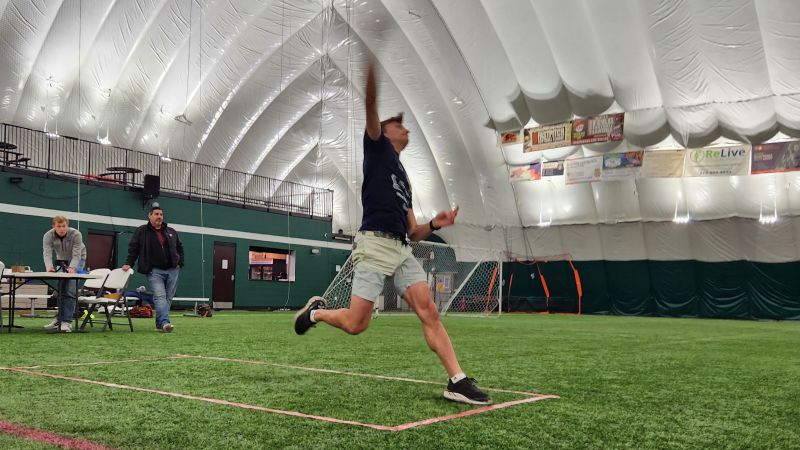Sign up for CNN’s Wonder Theory science newsletter. Explore the universe with news on fascinating discoveries, scientific advancements and more.
CNN
—
It’s a bird… It’s a plane… It’s a paper airplane!
The world record for the farthest flight by paper airplane has been broken by three aerospace engineers with a paper aircraft that flew a grand total of 289 feet, 9 inches (88 meters), nearly the length of an American football field.
They beat the previous record of 252 feet, 7 inches (77 meters) achieved on April 2022 by a trio in South Korea. Prior to that, the record had not been broken in over a decade.
“It really put things on the map and it’s a really proud moment for family and friends,” said Dillon Ruble, a systems engineer at Boeing and now paper airplane record holder, in a release. “It’s a good tie in to aerospace and thinking along the lines of designing and creating prototypes.”

Ruble worked alongside Garrett Jensen, a strength engineer also with Boeing, and aerospace engineer Nathaniel Erickson. The trio are recent graduates who studied aerospace engineering and mechanical engineering at Missouri University of Science and Technology.
The feat required months of effort, as the team put in nearly 500 hours of studying origami and aerodynamics to create and test multiple prototypes. The engineers put their final design to the test on December 2, 2022, in Crown Point, Indiana, where the record was achieved on Ruble’s third throw.
“We hope this record stands for quite a while — 290 feet (88 meters) is unreal,” Jensen said in the release. “That’s 14 to 15 feet (4.2 to 4.6 meters) over the farthest throw we ever did. It took a lot of planning and a lot of skill to beat the previous record.”
The team had decided their best chance at beating the world record would be with an airplane design that focused on speed and minimized drag, so that the plane could fly a far distance in a short amount of time.
Gathering inspiration from various hypersonic aircrafts, vehicles that can fly faster than five times the speed of sound (Mach 5), specifically the NASA X-43A, the team had come up with the winning paper aircraft design — later named “Mach 5.”
“Full-scale and paper airplanes have vast differences in their complexity, but both operate on the same fundamental principles,” said Ruble, via email. “Some of the same design methodologies can be applied to both. One of these methods was our trial-and-error design process. For instance, we would theorize about a fold we could change on our plane, fold it, throw it, and compare the distance to previous iterations to determine if the change was beneficial.”

To find the best technique when it came to throwing the paper airplane, the team ran various simulations and analyzed slow-motion videos of their previous throws.
“We found the optimal angle is about 40 degrees off the ground. Once you’re aiming that high, you throw as hard as possible. That gives us our best distance,” Jensen said in the statement. “It took simulations to figure that out. I didn’t think we could get useful data from a simulation on a paper airplane. Turns out, we could.”
Even down to the paper, which the team had decided that A4 (slightly longer than typical letter sized paper) was the best for manipulating and folding into the winning airplane. With these meticulously thought-out design choices, and careful attention to the numerous rules and guidelines set forth by the Guinness World Record Team, the three were set to break a record.
On its record-breaking distance flight the plane was in the air for roughly six seconds. The Guinness paper plane record for duration of flight is currently 29.2 seconds.
“The design objectives for an air-time record would be vastly different from the low-drag version we built for the longest-distance record,” Ruble said via email. “Increasing the wingspan and decreasing the aspect ratio would be the first steps in producing this type of plane.”
Paper airplane aside, Ruble added that this tedious method of back-and-forth trials served as a testament to the importance of rigorous prototyping in the real world.
Ruble and Jensen began their paper plane engineering careers while in middle school, participating in paper airplane events held at Boeing. Ruble said he enjoyed making the paper come to life and the hard work he had to put in to find ways to improve his designs. Both were also fans of origami as kids.
The record-breaking team hopes their accomplishment will inspire other young and aspiring aerospace engineers to chase their dreams.
For those looking to create their own record-breaking paper plane design, the feat is not impossible, but may take some time (and skill).
“Mach 5 flies best at high relative velocity, but to achieve this condition, the aircraft must be launched in a specific manner,” said Ruble via email. “This technique, in addition to the complexity of the plane, means that only the most experienced paper aircraft enthusiasts would have success with the design.
“However, by starting with publicly available designs, anyone can hone their skills to throw paper airplanes farther and higher than all of their friends,” he added.
